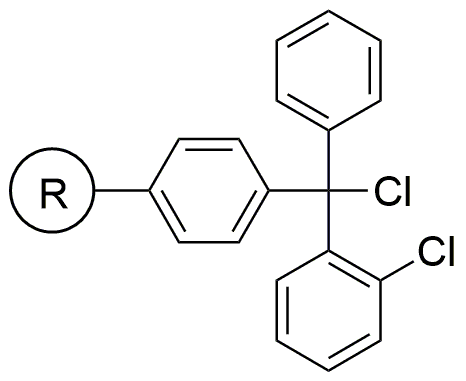2-Chlorotrityl chloride resin is widely utilized in research focused on:
- Solid-Phase Peptide Synthesis: This resin serves as a support for synthesizing peptides, allowing for efficient and controlled assembly of amino acids into desired sequences.
- Drug Development: It is employed in the creation of drug candidates by facilitating the attachment of various functional groups, streamlining the process of lead optimization in pharmaceutical research.
- Organic Synthesis: The resin acts as a versatile tool for chemists in organic synthesis, enabling the formation of complex molecules through selective reactions.
- Bioconjugation: It is used in bioconjugation techniques to link biomolecules, such as proteins or antibodies, to other compounds, enhancing the functionality of therapeutic agents.
- Analytical Chemistry: The resin aids in the purification and isolation of target compounds, improving the efficiency of analytical methods like HPLC and mass spectrometry.
General Information
Properties
Safety and Regulations
Applications
2-Chlorotrityl chloride resin is widely utilized in research focused on:
- Solid-Phase Peptide Synthesis: This resin serves as a support for synthesizing peptides, allowing for efficient and controlled assembly of amino acids into desired sequences.
- Drug Development: It is employed in the creation of drug candidates by facilitating the attachment of various functional groups, streamlining the process of lead optimization in pharmaceutical research.
- Organic Synthesis: The resin acts as a versatile tool for chemists in organic synthesis, enabling the formation of complex molecules through selective reactions.
- Bioconjugation: It is used in bioconjugation techniques to link biomolecules, such as proteins or antibodies, to other compounds, enhancing the functionality of therapeutic agents.
- Analytical Chemistry: The resin aids in the purification and isolation of target compounds, improving the efficiency of analytical methods like HPLC and mass spectrometry.
Documents
Safety Data Sheets (SDS)
The SDS provides comprehensive safety information on handling, storage, and disposal of the product.
Product Specification (PS)
The PS provides a comprehensive breakdown of the product’s properties, including chemical composition, physical state, purity, and storage requirements. It also details acceptable quality ranges and the product's intended applications.
Certificates of Analysis (COA)
Search for Certificates of Analysis (COA) by entering the products Lot Number. Lot and Batch Numbers can be found on a product’s label following the words ‘Lot’ or ‘Batch’.
*Catalog Number
*Lot Number
Certificates Of Origin (COO)
This COO confirms the country where the product was manufactured, and also details the materials and components used in it and whether it is derived from natural, synthetic, or other specific sources. This certificate may be required for customs, trade, and regulatory compliance.
*Catalog Number
*Lot Number
Safety Data Sheets (SDS)
The SDS provides comprehensive safety information on handling, storage, and disposal of the product.
DownloadProduct Specification (PS)
The PS provides a comprehensive breakdown of the product’s properties, including chemical composition, physical state, purity, and storage requirements. It also details acceptable quality ranges and the product's intended applications.
DownloadCertificates of Analysis (COA)
Search for Certificates of Analysis (COA) by entering the products Lot Number. Lot and Batch Numbers can be found on a product’s label following the words ‘Lot’ or ‘Batch’.
*Catalog Number
*Lot Number
Certificates Of Origin (COO)
This COO confirms the country where the product was manufactured, and also details the materials and components used in it and whether it is derived from natural, synthetic, or other specific sources. This certificate may be required for customs, trade, and regulatory compliance.


